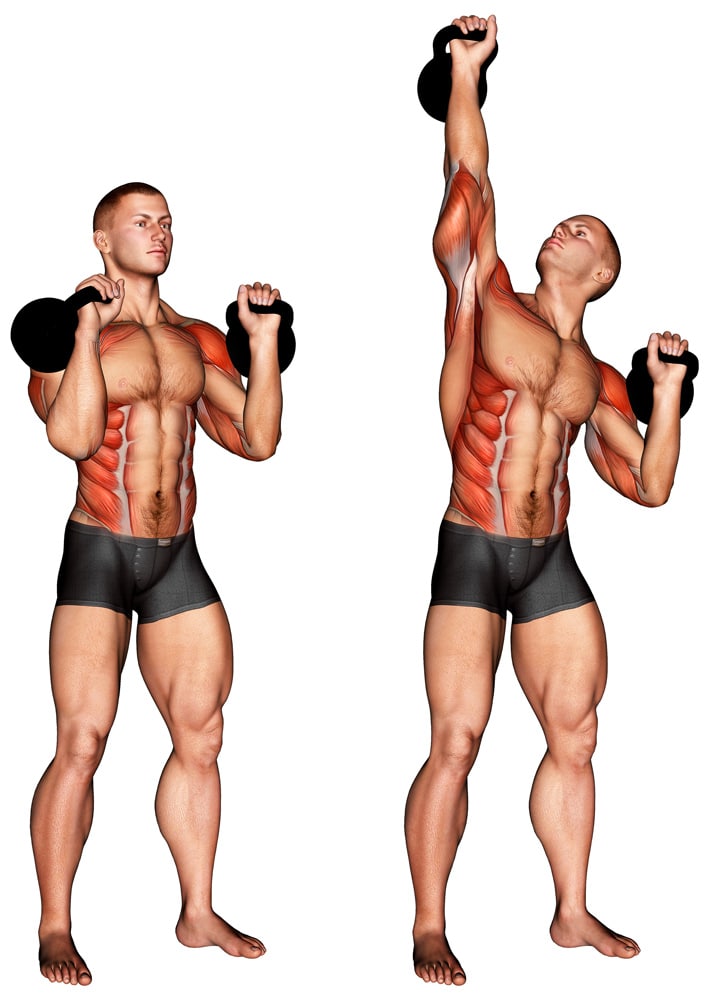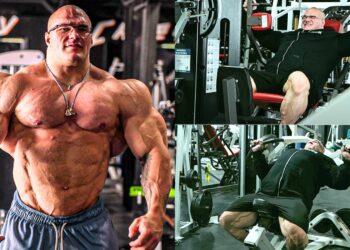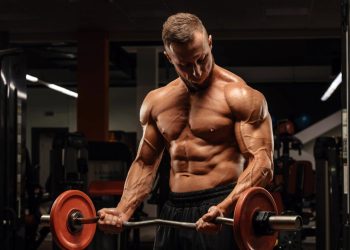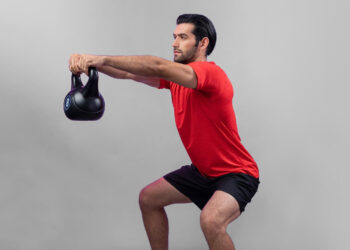The kettlebell seesaw press is a version of the alternating kettlebell overhead press. It has carryover to other exercises and there are also many variations of this movement. It’s not the simplest exercise to perform as you should know how to double clean kettlebells and then alternate pressing the weights overhead but with enough practice, we think it can be beneficial for everyone.
Learn about what muscles are involved, how to do it for best gains, benefits, variations, and how to include it in your training regime.
Summary
This is a kettlebell alternating press variation that we think is one of the best exercises you can do for the upper body. In this guide, you’ll learn about what muscles it works, how to do it, benefits, variations, and how to include it in your workouts.
How To Do The Kettlebell Seesaw Press
Before you perform the kettlebell seesaw press, you should know how to double clean kettlebells. This is the portion of the lift where you lift the kettlebells off the ground and into the front rack position before you do the alternating press.
It involves swinging the kettlebells between the legs and then lifting them into place.
If you do not know how to kettlebell double clean, we highly recommend you watch this video.
Related: Kettlebell Sumo High Pull — How To, Variations and Muscles Worked
Level Up Your Fitness: Join our 💪 strong community in Fitness Volt Newsletter. Get daily inspiration, expert-backed workouts, nutrition tips, the latest in strength sports, and the support you need to reach your goals. Subscribe for free!
Here are step-by-step instructions for the kettlebell seesaw press.
- Place the kettlebells on the floor touching each other and with the handles vertical to your body, so that you can pick them up using a reverse neutral grip.
- Stand over the kettlebells so that your feet are touching them on the side or create a few-inch space between your legs and the weights. It also depends on the kettlebell size. A good stance is usually a little wider than the shoulders.
- Point your toes slightly outward or keep them straight depending on which is more comfortable for you. You want to ensure you have a solid base
- Move the kettlebells about a foot and a half in front of you on the ground
- Grab the kettlebells by rotating both of your wrists so the palms are facing away from each other. Yes, this will feel a little awkward but it’s a very efficient and effective way to get the weights into place
- Keep your core tense, back straight, and then hinge forward at the hips and grip the kettlebells
- Swing the kettlebells back between your legs, and then push hard through your feet to extend the knees. As you do this, rotate the kettlebells around your wrists which should land the ball part of the weight on the forearm and upper arm. Make sure to squeeze the glutes and push the hips forward at the same time. Lockout your knees.
- While holding the kettlebells in position, the palms should be facing your body while the forearms should be vertical to the ground, not too far inward or flared out
- Maintain a tense core, and continue to squeeze your butt muscles
- Now, press one kettlebell directly overhead by rotating your wrist so that it’s now facing away from you. The other arm should remain in the front rack position
- Bring the kettlebell down to the starting position by rotating the wrist so it’s facing your chest, and then repeat the press with the opposite arm
- Alternate both arms for the desired number of reps but make sure to perform an equal number of reps for each arm.
Placing the kettlebells back on the ground.
This part of the lift may be just as important because many hurt themselves attempting to set the kettlebells back down. That’s why it’s recommended to have some experience doing exercises that involve using two kettlebells at the same time.
- To do this, pull your hands in opposite directions to avoid banging them against each other, then as you bring them down, rotate your wrists to palms facing out and swing the kettlebells between your legs. Then, carefully set them on the floor
Here’s a great video tutorial that we recommend you take a few minutes to watch if you want to perfect this movement and be as efficient as possible. Although, you can just follow the written instructions if you have more training experience and a proper understanding of how to perform similar movements.
Kettlebell Seesaw Press Benefits
Let’s discuss some of the reasons you should do the kettlebell seesaw press.
Build stronger and rounder delts
Kettlebell training is not just for functional fitness. You can still build tons of strength and muscle using this unique training implement as long as you’re progressing with the weight and reps.
Kettlebell presses are also great because you have to stabilize the weight which also improves stability in the shoulder joint. As you probably know, the shoulders are a ball and socket joint prone to injuries and it helps to do movements like these for short and long-term longevity of the joints.
Learn and improve movement control
You cannot rush heavy kettlebell overhead presses (or any weights), both for safety and effectiveness. Any shoulder press using the oddly-shaped kettlebell will really challenge you to balance the weight overhead but also keep it overhead and not in an awkward position which makes the movement less efficient.
Has carry over to other exercises
If you do Olympic-style lifting, CrossFit, or simply want to get better at functional fitness and strength training, then doing alternating overhead presses using a kettlebell should have carryover to these activities.
Freeweight training is anything but stable and weak primary or secondary muscles can cause energy leaks that affect your performance.
Build a more resilient core
Your core group of muscles are crucial when it comes to doing any form of exercise, especially ones that involve the entire body. If you cannot brace your midsection and keep it rigid enough, well, you won’t be able to lift moderate to heavy loads.
The good news is, resistance training builds a stronger core the more you progress in your workouts.
Include variety in your training
The kettlebell seesaw press mixes things up from the average workout program that focus on the basic lifts. And because the kettlebell is a unique design, it’ll challenge the muscles and stabilizers in a different way, especially when you start using heavier weights.
Kettlebell Seesaw Press Drawbacks
There’s one drawback to this exercise, in our opinion.
Requires some kettlebell training experience or lifting knowledge
This is especially important for the first part of the kettlebell seesaw press when you have to double clean the weights by using a swing to get them into position.
If using light kettlebells, you could get away with simply picking up the weights and getting them into position. However, it’s most efficient to do a double clean, especially if you plan to progress with this movement and do it safely both when picking up and setting the kettlebells back down.
There’s a right and wrong way to use kettlebells.
Kettlebell Seesaw Press Variations
The kettlebell seesaw press has its own advantages. But we also like these variations that mix up training and target different components of fitness and performance ability.
Bent press
The bent press is a great exercise but also a good progression movement before you do a single and double kettlebell press. It helps to develop the muscles that assist and stabilize.
Kettlebell windmill
The kettlebell windmill is another progression to the single or double kettlebell press. It helps to strengthen the muscles in the torso that play such a big role in stabilization. In fact, we highly recommend getting stronger at this movement before attempting heavy single and double kettlebell presses.
Dumbbell seesaw press
While we prefer kettlebells here, you could also use dumbbells whether you just prefer them or you don’t have access to kettlebells.
Level Up Your Fitness: Join our 💪 strong community in Fitness Volt Newsletter. Get daily inspiration, expert-backed workouts, nutrition tips, the latest in strength sports, and the support you need to reach your goals. Subscribe for free!
Here’s a video showing how to do the dumbbell kettlebell clean.
Double kettlebell overhead press
Pressing two kettlebells overhead at the same time is a good way to mix up your training. However, it’s more challenging considering you now have to press and balance two kettlebells overhead.
This is a more advanced exercise and you should be able to do a single-arm kettlebell press before you can safely and effectively do the kettlebell double press.
Watch this video tutorial to learn this press.
Kettlebell double to seesaw press
If you want to challenge yourself even more, the kettlebell double to seesaw press is where it’s at. This movement combines the two-arm press and seesaw press.
To do it:
- Press both kettlebells overhead at the same time and bring them back down to the starting front rack position
- Press the left kettlebell overhead, bring it back down, then press the right overhead and bring it to the starting position
- Then press both kettlebells simultaneously again and lower them to the shoulders
- Now, press the right kettlebell overhead and lower it back down then press the left kettlebell and bring it back down
You want to alternate this pattern for the desired number of reps.
Using Kettlebell Seesaw Press in Your Workouts
There are a lot of great ways to incorporate this movement and each one may offer its own unique advantage. Training variety is very important for making progress but also preventing boredom which is actually more important than a lot of people realize.
Here are some ways we would incorporate this exercise in our workouts.
CrossFit workouts
CrossFit involves a lot of kettlebell focused exercises and training and the clean and press are very common in these types of workouts.
Circuits
Circuit training involves performing several exercises one after the other with little to no rest in between. This is one of the exercises we’d add in because it’s challenging, keeps your heart rate up, and burns calories.
Straight sets
You actually don’t have to do a special workout to do this exercise. You can do the standard 3-4 sets with 30-60 seconds rest in between. This may also be the best option if you’re using heavy kettlebells because it will allow you to take longer rests in between and focus on increasing the poundages.
Sets and reps
There’s no perfect strategy here as you should train according to your goals. We recommend using all different sets and reps combinations to maximize your progress. Here are our set and rep recommendations depending on what your focus is.
- For strength – 3-5 sets x 5-7 reps
- For hypertrophy – 3 sets x 8-15 reps
- For muscular endurance/functional fitness – 3 sets x 15-35 reps
Kettlebell Seesaw Press Muscles Worked
The kettlebell seesaw press works a variety of muscle groups including some that help to assist in the exercise. We’ve included descriptions for the muscles involved below.

Deltoid Anterior
The shoulder is largely formed by three heads or sections of muscle fibers – anterior, lateral, and posterior deltoid muscles. The anterior fibers are located at the frontside of the body directly above the biceps. When you lift your arm forward to shake someone’s hand, you’re activating the front head via flexion of the arm.
Deltoid Lateral
The deltoid lateral or middle delts are sandwiched between the anterior and posterior deltoids. When you raise your arms out to the side to form a “T” shape with your body, the side delts are doing their job. Of the three shoulder muscles, the lateral delts create the appearance of a wider upper body.
Serratus Anterior
The serratus anterior is a torso muscle that isn’t acknowledged as much as the other more popular core muscles such the abs and obliques. However, this fan-shaped muscle has a function which is to assist in protracting the arms forward, upward rotation of the shoulder blades and raising the arms overhead.
Triceps brachii
Opposite the biceps on the posterior upper arm, the three headed triceps brachii is a “pushing” muscle involved in all similar movements that extend the arm which is it’s primary purpose.
Pectoralis Major Clavicular Head
While it’s not the target muscle in overhead presses, the upper chest fibers assist in flexion of the arm forward. Therefore, you’ll get some chest activation near the upper clavicle area.
Rectus abdominis
When you perform a crunch or brace your midsection before squatting under heavy weight, it’s the external and deeper core muscles, respectively that allow us to do both.
Obliques
You can find the oblique muscles on either side of your main abdominal muscles in the center part of your anterior torso. Different from the abdominals, the obliques contribute to trunk rotation and contralateral rotation, and with the erector spinae and rectus abdominis, they help with lateral flexion of the trunk. While there’s not much rotation during the seesaw press, the obliques are still engaged.
Wrapping Up
The kettlebell seesaw press is a phenomenal exercise variation that we recommend for any and everyone. It has so many benefits and is one of the best ways to mix up your upper body training, in our opinion.
Kettlebell training has its own advantages, one of which is that it’s absolutely great for improving functional aspects of fitness.
Try this exercise next time you train if it’s not already a regular movement in your routine and we think you’ll understand why it can be great for your progress. There are also some awesome variations of the kettlebell seesaw press and we encourage using them too as training should be fun and exciting as well as effective.
Interested in measuring your progress? Check out our strength standards for Clean and Press, Clean, Shoulder Press, and more.








